Strategic Position Plan for Bidfood, Australia: TMGT601 Report
VerifiedAdded on 2023/03/31
|10
|2355
|72
Report
AI Summary
This report presents a strategic position plan for Bidfood, an Australian food industry leader. It begins with an introduction to strategic positioning and the company's background, including its vision and product offerings like chicken roulade and seasoned ribs. The rationale for the chosen strategy is discussed, highlighting the competitive landscape and the need for business-level strategies. The report then delves into specific strategies, such as cost leadership, and evaluates their suitability, feasibility, and acceptability to stakeholders. The implementation of subclasses of products is also examined. A balanced scorecard approach is proposed to monitor performance across customer, financial, learning and growth, and internal process perspectives. The report concludes with recommendations to maintain product quality and customer satisfaction, emphasizing the importance of strategic planning for Bidfood's continued success in the market. The report is an assignment for the TMGT601 course.
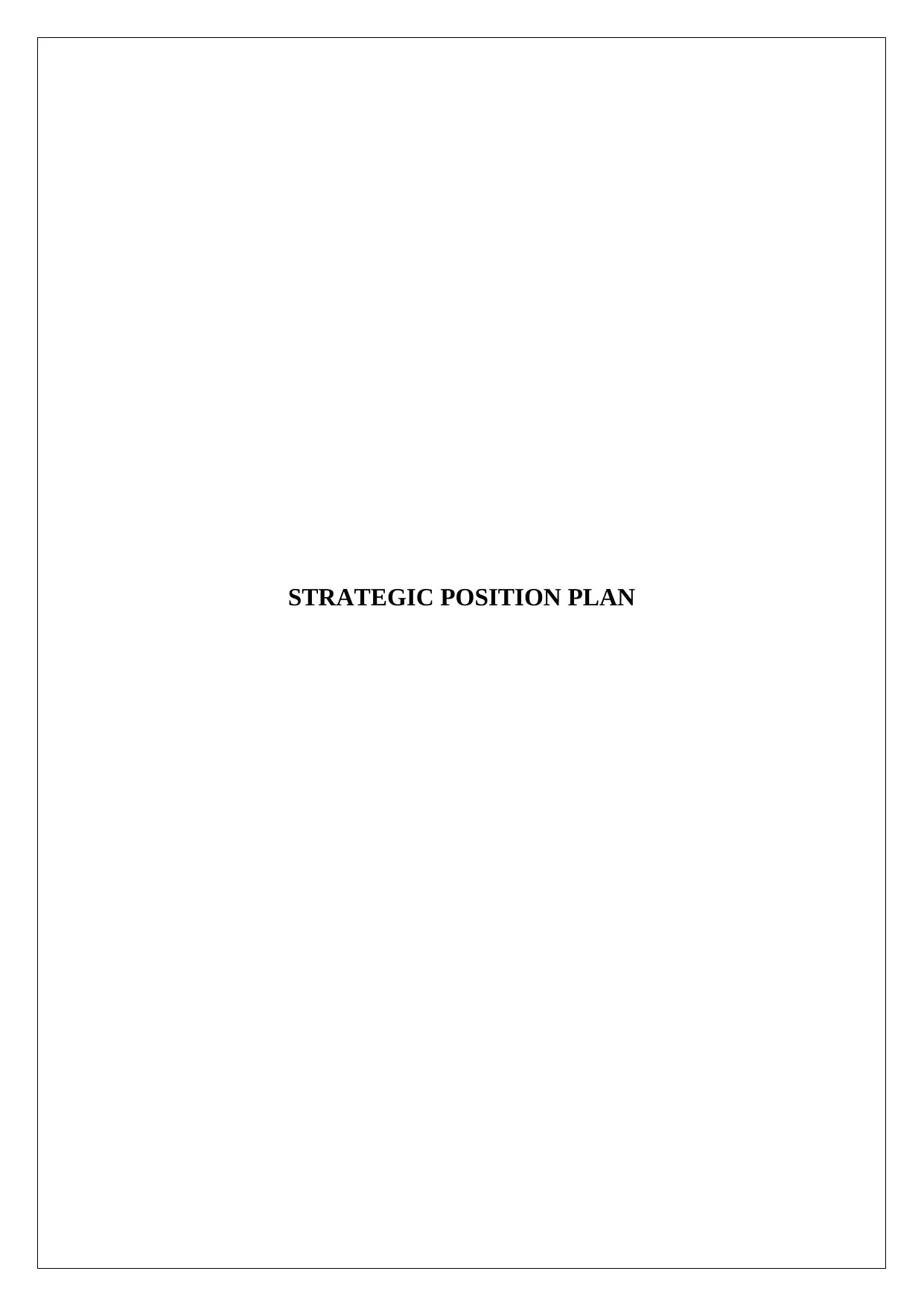
STRATEGIC POSITION PLAN
Paraphrase This Document
Need a fresh take? Get an instant paraphrase of this document with our AI Paraphraser
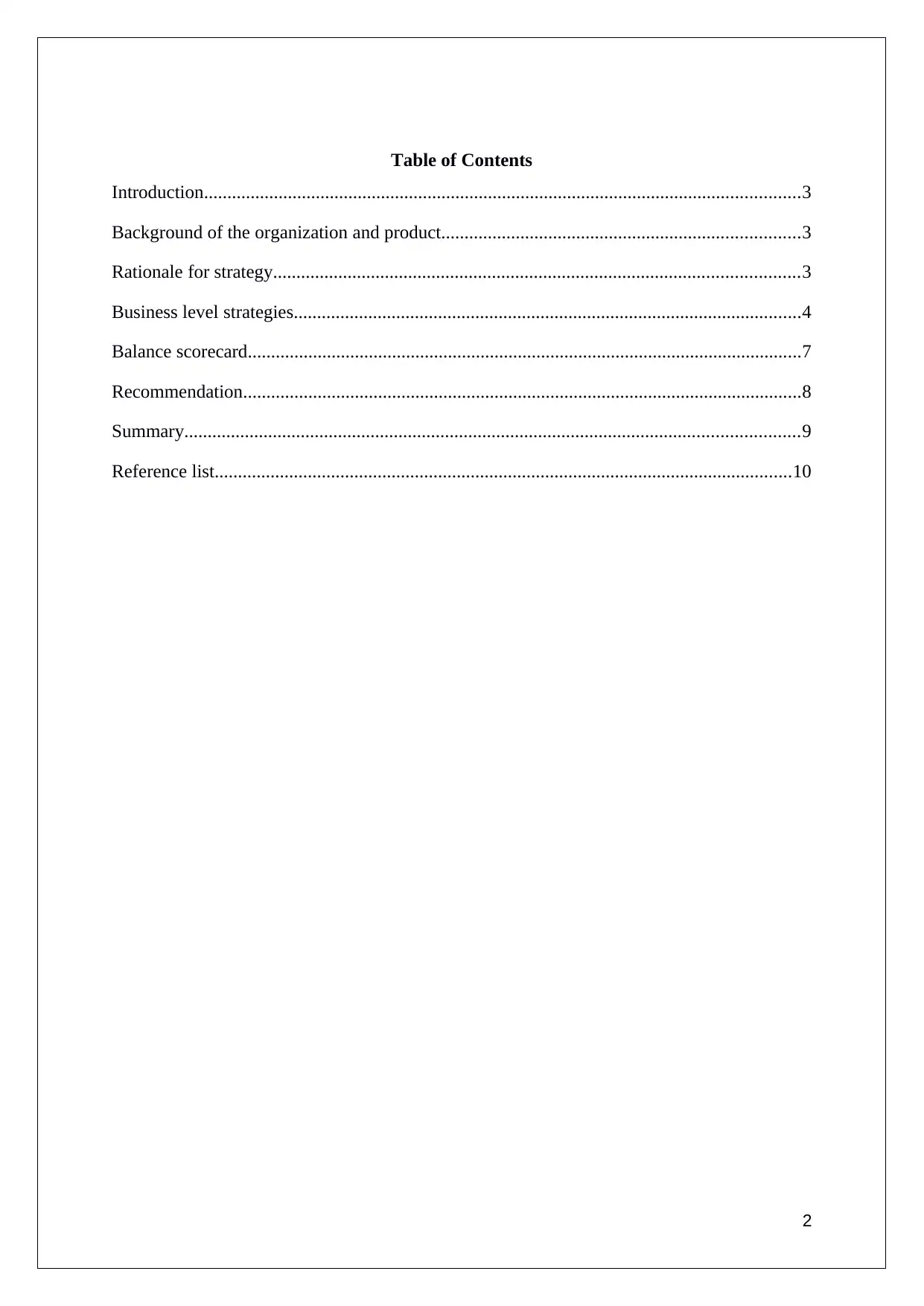
Table of Contents
Introduction................................................................................................................................3
Background of the organization and product.............................................................................3
Rationale for strategy.................................................................................................................3
Business level strategies.............................................................................................................4
Balance scorecard.......................................................................................................................7
Recommendation........................................................................................................................8
Summary....................................................................................................................................9
Reference list............................................................................................................................10
2
Introduction................................................................................................................................3
Background of the organization and product.............................................................................3
Rationale for strategy.................................................................................................................3
Business level strategies.............................................................................................................4
Balance scorecard.......................................................................................................................7
Recommendation........................................................................................................................8
Summary....................................................................................................................................9
Reference list............................................................................................................................10
2
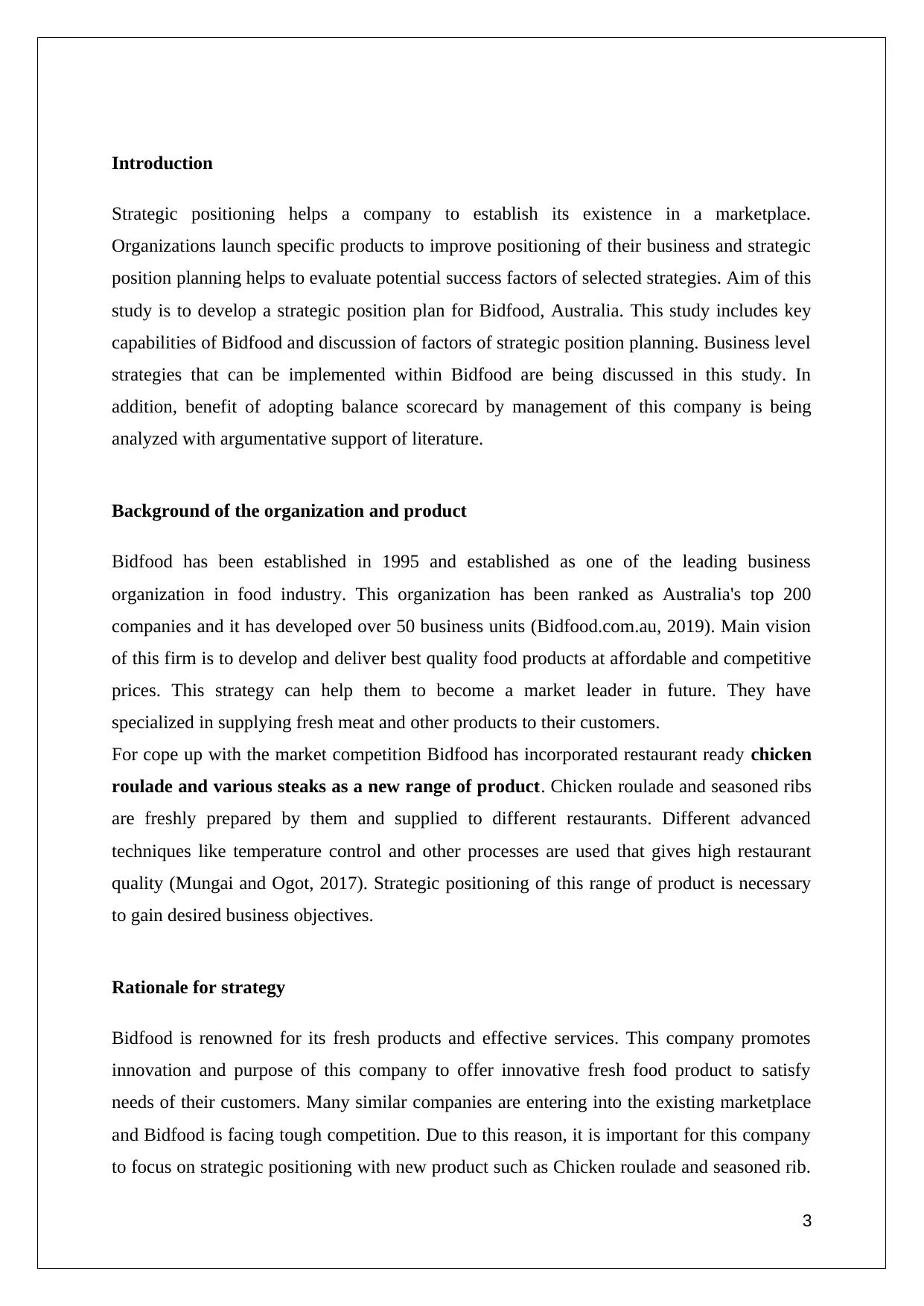
Introduction
Strategic positioning helps a company to establish its existence in a marketplace.
Organizations launch specific products to improve positioning of their business and strategic
position planning helps to evaluate potential success factors of selected strategies. Aim of this
study is to develop a strategic position plan for Bidfood, Australia. This study includes key
capabilities of Bidfood and discussion of factors of strategic position planning. Business level
strategies that can be implemented within Bidfood are being discussed in this study. In
addition, benefit of adopting balance scorecard by management of this company is being
analyzed with argumentative support of literature.
Background of the organization and product
Bidfood has been established in 1995 and established as one of the leading business
organization in food industry. This organization has been ranked as Australia's top 200
companies and it has developed over 50 business units (Bidfood.com.au, 2019). Main vision
of this firm is to develop and deliver best quality food products at affordable and competitive
prices. This strategy can help them to become a market leader in future. They have
specialized in supplying fresh meat and other products to their customers.
For cope up with the market competition Bidfood has incorporated restaurant ready chicken
roulade and various steaks as a new range of product. Chicken roulade and seasoned ribs
are freshly prepared by them and supplied to different restaurants. Different advanced
techniques like temperature control and other processes are used that gives high restaurant
quality (Mungai and Ogot, 2017). Strategic positioning of this range of product is necessary
to gain desired business objectives.
Rationale for strategy
Bidfood is renowned for its fresh products and effective services. This company promotes
innovation and purpose of this company to offer innovative fresh food product to satisfy
needs of their customers. Many similar companies are entering into the existing marketplace
and Bidfood is facing tough competition. Due to this reason, it is important for this company
to focus on strategic positioning with new product such as Chicken roulade and seasoned rib.
3
Strategic positioning helps a company to establish its existence in a marketplace.
Organizations launch specific products to improve positioning of their business and strategic
position planning helps to evaluate potential success factors of selected strategies. Aim of this
study is to develop a strategic position plan for Bidfood, Australia. This study includes key
capabilities of Bidfood and discussion of factors of strategic position planning. Business level
strategies that can be implemented within Bidfood are being discussed in this study. In
addition, benefit of adopting balance scorecard by management of this company is being
analyzed with argumentative support of literature.
Background of the organization and product
Bidfood has been established in 1995 and established as one of the leading business
organization in food industry. This organization has been ranked as Australia's top 200
companies and it has developed over 50 business units (Bidfood.com.au, 2019). Main vision
of this firm is to develop and deliver best quality food products at affordable and competitive
prices. This strategy can help them to become a market leader in future. They have
specialized in supplying fresh meat and other products to their customers.
For cope up with the market competition Bidfood has incorporated restaurant ready chicken
roulade and various steaks as a new range of product. Chicken roulade and seasoned ribs
are freshly prepared by them and supplied to different restaurants. Different advanced
techniques like temperature control and other processes are used that gives high restaurant
quality (Mungai and Ogot, 2017). Strategic positioning of this range of product is necessary
to gain desired business objectives.
Rationale for strategy
Bidfood is renowned for its fresh products and effective services. This company promotes
innovation and purpose of this company to offer innovative fresh food product to satisfy
needs of their customers. Many similar companies are entering into the existing marketplace
and Bidfood is facing tough competition. Due to this reason, it is important for this company
to focus on strategic positioning with new product such as Chicken roulade and seasoned rib.
3
⊘ This is a preview!⊘
Do you want full access?
Subscribe today to unlock all pages.

Trusted by 1+ million students worldwide
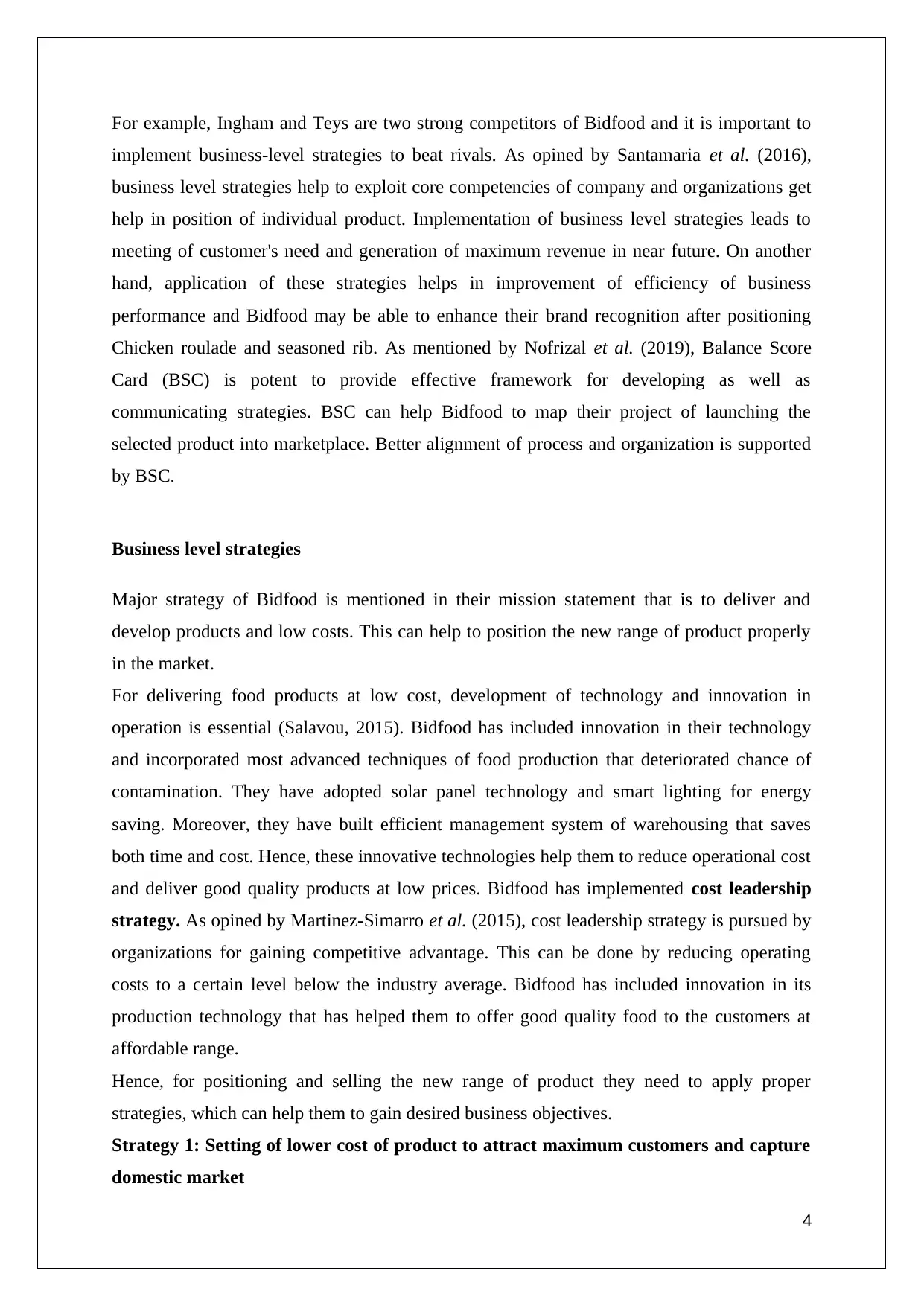
For example, Ingham and Teys are two strong competitors of Bidfood and it is important to
implement business-level strategies to beat rivals. As opined by Santamaria et al. (2016),
business level strategies help to exploit core competencies of company and organizations get
help in position of individual product. Implementation of business level strategies leads to
meeting of customer's need and generation of maximum revenue in near future. On another
hand, application of these strategies helps in improvement of efficiency of business
performance and Bidfood may be able to enhance their brand recognition after positioning
Chicken roulade and seasoned rib. As mentioned by Nofrizal et al. (2019), Balance Score
Card (BSC) is potent to provide effective framework for developing as well as
communicating strategies. BSC can help Bidfood to map their project of launching the
selected product into marketplace. Better alignment of process and organization is supported
by BSC.
Business level strategies
Major strategy of Bidfood is mentioned in their mission statement that is to deliver and
develop products and low costs. This can help to position the new range of product properly
in the market.
For delivering food products at low cost, development of technology and innovation in
operation is essential (Salavou, 2015). Bidfood has included innovation in their technology
and incorporated most advanced techniques of food production that deteriorated chance of
contamination. They have adopted solar panel technology and smart lighting for energy
saving. Moreover, they have built efficient management system of warehousing that saves
both time and cost. Hence, these innovative technologies help them to reduce operational cost
and deliver good quality products at low prices. Bidfood has implemented cost leadership
strategy. As opined by Martinez-Simarro et al. (2015), cost leadership strategy is pursued by
organizations for gaining competitive advantage. This can be done by reducing operating
costs to a certain level below the industry average. Bidfood has included innovation in its
production technology that has helped them to offer good quality food to the customers at
affordable range.
Hence, for positioning and selling the new range of product they need to apply proper
strategies, which can help them to gain desired business objectives.
Strategy 1: Setting of lower cost of product to attract maximum customers and capture
domestic market
4
implement business-level strategies to beat rivals. As opined by Santamaria et al. (2016),
business level strategies help to exploit core competencies of company and organizations get
help in position of individual product. Implementation of business level strategies leads to
meeting of customer's need and generation of maximum revenue in near future. On another
hand, application of these strategies helps in improvement of efficiency of business
performance and Bidfood may be able to enhance their brand recognition after positioning
Chicken roulade and seasoned rib. As mentioned by Nofrizal et al. (2019), Balance Score
Card (BSC) is potent to provide effective framework for developing as well as
communicating strategies. BSC can help Bidfood to map their project of launching the
selected product into marketplace. Better alignment of process and organization is supported
by BSC.
Business level strategies
Major strategy of Bidfood is mentioned in their mission statement that is to deliver and
develop products and low costs. This can help to position the new range of product properly
in the market.
For delivering food products at low cost, development of technology and innovation in
operation is essential (Salavou, 2015). Bidfood has included innovation in their technology
and incorporated most advanced techniques of food production that deteriorated chance of
contamination. They have adopted solar panel technology and smart lighting for energy
saving. Moreover, they have built efficient management system of warehousing that saves
both time and cost. Hence, these innovative technologies help them to reduce operational cost
and deliver good quality products at low prices. Bidfood has implemented cost leadership
strategy. As opined by Martinez-Simarro et al. (2015), cost leadership strategy is pursued by
organizations for gaining competitive advantage. This can be done by reducing operating
costs to a certain level below the industry average. Bidfood has included innovation in its
production technology that has helped them to offer good quality food to the customers at
affordable range.
Hence, for positioning and selling the new range of product they need to apply proper
strategies, which can help them to gain desired business objectives.
Strategy 1: Setting of lower cost of product to attract maximum customers and capture
domestic market
4
Paraphrase This Document
Need a fresh take? Get an instant paraphrase of this document with our AI Paraphraser
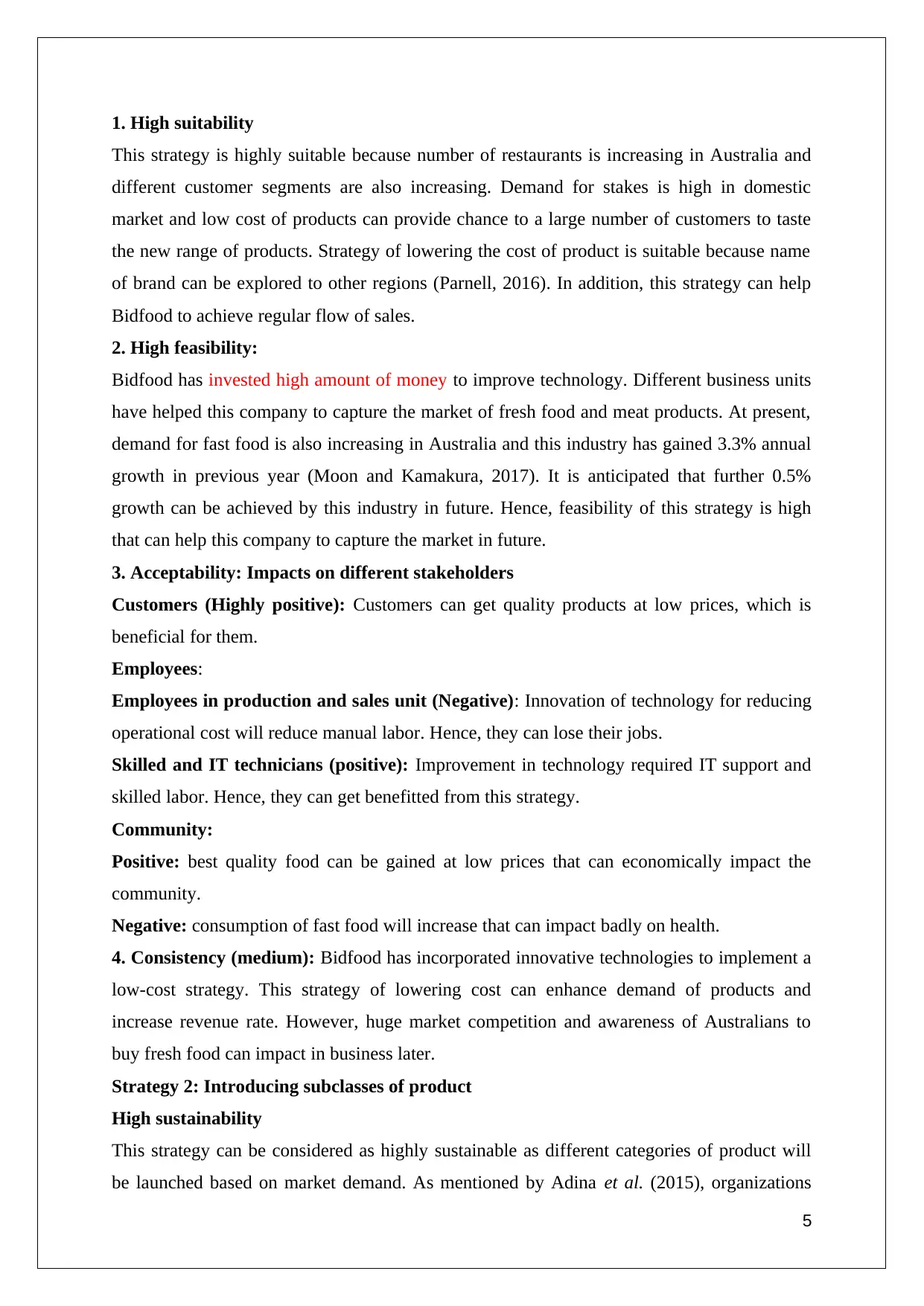
1. High suitability
This strategy is highly suitable because number of restaurants is increasing in Australia and
different customer segments are also increasing. Demand for stakes is high in domestic
market and low cost of products can provide chance to a large number of customers to taste
the new range of products. Strategy of lowering the cost of product is suitable because name
of brand can be explored to other regions (Parnell, 2016). In addition, this strategy can help
Bidfood to achieve regular flow of sales.
2. High feasibility:
Bidfood has invested high amount of money to improve technology. Different business units
have helped this company to capture the market of fresh food and meat products. At present,
demand for fast food is also increasing in Australia and this industry has gained 3.3% annual
growth in previous year (Moon and Kamakura, 2017). It is anticipated that further 0.5%
growth can be achieved by this industry in future. Hence, feasibility of this strategy is high
that can help this company to capture the market in future.
3. Acceptability: Impacts on different stakeholders
Customers (Highly positive): Customers can get quality products at low prices, which is
beneficial for them.
Employees:
Employees in production and sales unit (Negative): Innovation of technology for reducing
operational cost will reduce manual labor. Hence, they can lose their jobs.
Skilled and IT technicians (positive): Improvement in technology required IT support and
skilled labor. Hence, they can get benefitted from this strategy.
Community:
Positive: best quality food can be gained at low prices that can economically impact the
community.
Negative: consumption of fast food will increase that can impact badly on health.
4. Consistency (medium): Bidfood has incorporated innovative technologies to implement a
low-cost strategy. This strategy of lowering cost can enhance demand of products and
increase revenue rate. However, huge market competition and awareness of Australians to
buy fresh food can impact in business later.
Strategy 2: Introducing subclasses of product
High sustainability
This strategy can be considered as highly sustainable as different categories of product will
be launched based on market demand. As mentioned by Adina et al. (2015), organizations
5
This strategy is highly suitable because number of restaurants is increasing in Australia and
different customer segments are also increasing. Demand for stakes is high in domestic
market and low cost of products can provide chance to a large number of customers to taste
the new range of products. Strategy of lowering the cost of product is suitable because name
of brand can be explored to other regions (Parnell, 2016). In addition, this strategy can help
Bidfood to achieve regular flow of sales.
2. High feasibility:
Bidfood has invested high amount of money to improve technology. Different business units
have helped this company to capture the market of fresh food and meat products. At present,
demand for fast food is also increasing in Australia and this industry has gained 3.3% annual
growth in previous year (Moon and Kamakura, 2017). It is anticipated that further 0.5%
growth can be achieved by this industry in future. Hence, feasibility of this strategy is high
that can help this company to capture the market in future.
3. Acceptability: Impacts on different stakeholders
Customers (Highly positive): Customers can get quality products at low prices, which is
beneficial for them.
Employees:
Employees in production and sales unit (Negative): Innovation of technology for reducing
operational cost will reduce manual labor. Hence, they can lose their jobs.
Skilled and IT technicians (positive): Improvement in technology required IT support and
skilled labor. Hence, they can get benefitted from this strategy.
Community:
Positive: best quality food can be gained at low prices that can economically impact the
community.
Negative: consumption of fast food will increase that can impact badly on health.
4. Consistency (medium): Bidfood has incorporated innovative technologies to implement a
low-cost strategy. This strategy of lowering cost can enhance demand of products and
increase revenue rate. However, huge market competition and awareness of Australians to
buy fresh food can impact in business later.
Strategy 2: Introducing subclasses of product
High sustainability
This strategy can be considered as highly sustainable as different categories of product will
be launched based on market demand. As mentioned by Adina et al. (2015), organizations
5
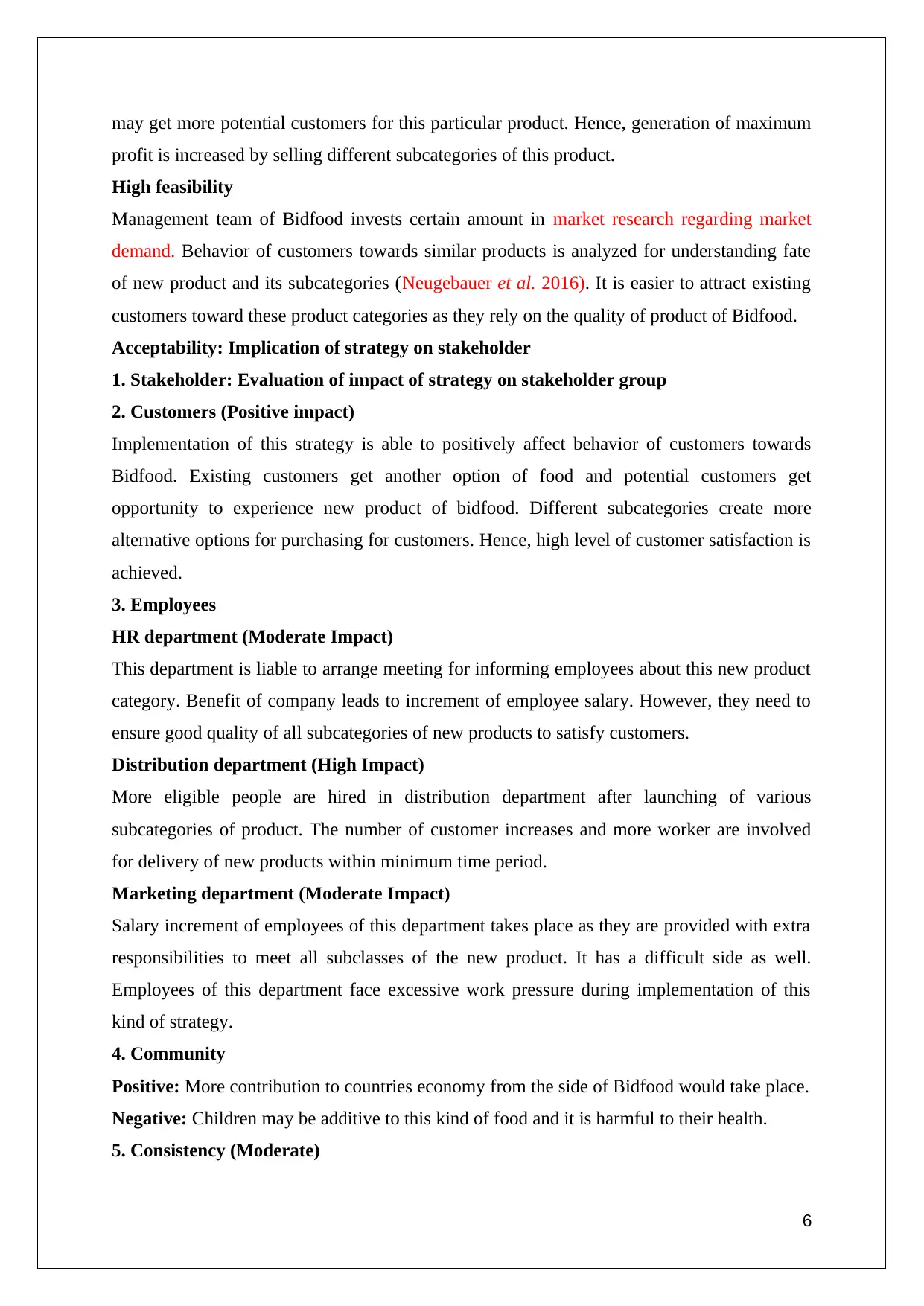
may get more potential customers for this particular product. Hence, generation of maximum
profit is increased by selling different subcategories of this product.
High feasibility
Management team of Bidfood invests certain amount in market research regarding market
demand. Behavior of customers towards similar products is analyzed for understanding fate
of new product and its subcategories (Neugebauer et al. 2016). It is easier to attract existing
customers toward these product categories as they rely on the quality of product of Bidfood.
Acceptability: Implication of strategy on stakeholder
1. Stakeholder: Evaluation of impact of strategy on stakeholder group
2. Customers (Positive impact)
Implementation of this strategy is able to positively affect behavior of customers towards
Bidfood. Existing customers get another option of food and potential customers get
opportunity to experience new product of bidfood. Different subcategories create more
alternative options for purchasing for customers. Hence, high level of customer satisfaction is
achieved.
3. Employees
HR department (Moderate Impact)
This department is liable to arrange meeting for informing employees about this new product
category. Benefit of company leads to increment of employee salary. However, they need to
ensure good quality of all subcategories of new products to satisfy customers.
Distribution department (High Impact)
More eligible people are hired in distribution department after launching of various
subcategories of product. The number of customer increases and more worker are involved
for delivery of new products within minimum time period.
Marketing department (Moderate Impact)
Salary increment of employees of this department takes place as they are provided with extra
responsibilities to meet all subclasses of the new product. It has a difficult side as well.
Employees of this department face excessive work pressure during implementation of this
kind of strategy.
4. Community
Positive: More contribution to countries economy from the side of Bidfood would take place.
Negative: Children may be additive to this kind of food and it is harmful to their health.
5. Consistency (Moderate)
6
profit is increased by selling different subcategories of this product.
High feasibility
Management team of Bidfood invests certain amount in market research regarding market
demand. Behavior of customers towards similar products is analyzed for understanding fate
of new product and its subcategories (Neugebauer et al. 2016). It is easier to attract existing
customers toward these product categories as they rely on the quality of product of Bidfood.
Acceptability: Implication of strategy on stakeholder
1. Stakeholder: Evaluation of impact of strategy on stakeholder group
2. Customers (Positive impact)
Implementation of this strategy is able to positively affect behavior of customers towards
Bidfood. Existing customers get another option of food and potential customers get
opportunity to experience new product of bidfood. Different subcategories create more
alternative options for purchasing for customers. Hence, high level of customer satisfaction is
achieved.
3. Employees
HR department (Moderate Impact)
This department is liable to arrange meeting for informing employees about this new product
category. Benefit of company leads to increment of employee salary. However, they need to
ensure good quality of all subcategories of new products to satisfy customers.
Distribution department (High Impact)
More eligible people are hired in distribution department after launching of various
subcategories of product. The number of customer increases and more worker are involved
for delivery of new products within minimum time period.
Marketing department (Moderate Impact)
Salary increment of employees of this department takes place as they are provided with extra
responsibilities to meet all subclasses of the new product. It has a difficult side as well.
Employees of this department face excessive work pressure during implementation of this
kind of strategy.
4. Community
Positive: More contribution to countries economy from the side of Bidfood would take place.
Negative: Children may be additive to this kind of food and it is harmful to their health.
5. Consistency (Moderate)
6
⊘ This is a preview!⊘
Do you want full access?
Subscribe today to unlock all pages.

Trusted by 1+ million students worldwide
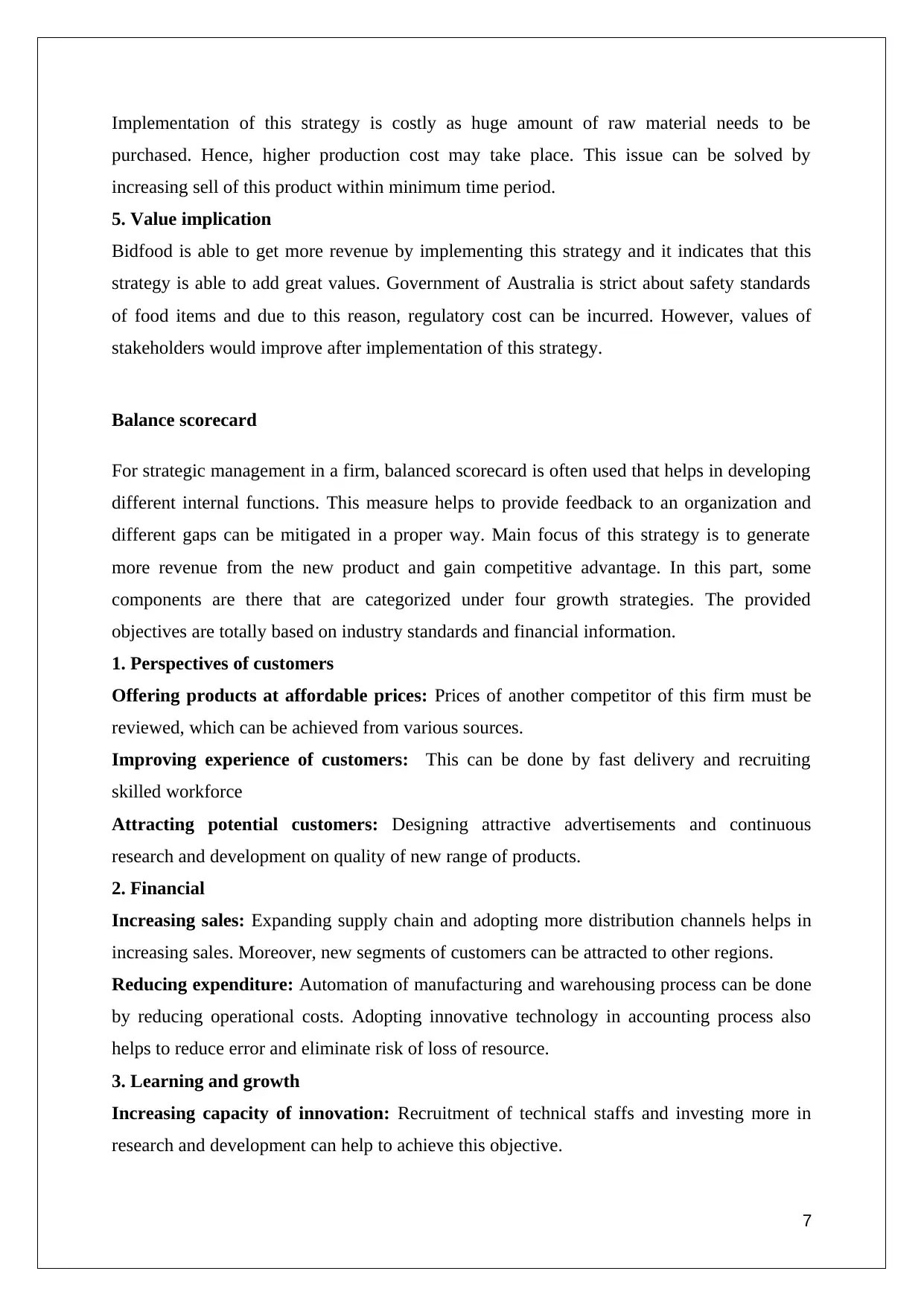
Implementation of this strategy is costly as huge amount of raw material needs to be
purchased. Hence, higher production cost may take place. This issue can be solved by
increasing sell of this product within minimum time period.
5. Value implication
Bidfood is able to get more revenue by implementing this strategy and it indicates that this
strategy is able to add great values. Government of Australia is strict about safety standards
of food items and due to this reason, regulatory cost can be incurred. However, values of
stakeholders would improve after implementation of this strategy.
Balance scorecard
For strategic management in a firm, balanced scorecard is often used that helps in developing
different internal functions. This measure helps to provide feedback to an organization and
different gaps can be mitigated in a proper way. Main focus of this strategy is to generate
more revenue from the new product and gain competitive advantage. In this part, some
components are there that are categorized under four growth strategies. The provided
objectives are totally based on industry standards and financial information.
1. Perspectives of customers
Offering products at affordable prices: Prices of another competitor of this firm must be
reviewed, which can be achieved from various sources.
Improving experience of customers: This can be done by fast delivery and recruiting
skilled workforce
Attracting potential customers: Designing attractive advertisements and continuous
research and development on quality of new range of products.
2. Financial
Increasing sales: Expanding supply chain and adopting more distribution channels helps in
increasing sales. Moreover, new segments of customers can be attracted to other regions.
Reducing expenditure: Automation of manufacturing and warehousing process can be done
by reducing operational costs. Adopting innovative technology in accounting process also
helps to reduce error and eliminate risk of loss of resource.
3. Learning and growth
Increasing capacity of innovation: Recruitment of technical staffs and investing more in
research and development can help to achieve this objective.
7
purchased. Hence, higher production cost may take place. This issue can be solved by
increasing sell of this product within minimum time period.
5. Value implication
Bidfood is able to get more revenue by implementing this strategy and it indicates that this
strategy is able to add great values. Government of Australia is strict about safety standards
of food items and due to this reason, regulatory cost can be incurred. However, values of
stakeholders would improve after implementation of this strategy.
Balance scorecard
For strategic management in a firm, balanced scorecard is often used that helps in developing
different internal functions. This measure helps to provide feedback to an organization and
different gaps can be mitigated in a proper way. Main focus of this strategy is to generate
more revenue from the new product and gain competitive advantage. In this part, some
components are there that are categorized under four growth strategies. The provided
objectives are totally based on industry standards and financial information.
1. Perspectives of customers
Offering products at affordable prices: Prices of another competitor of this firm must be
reviewed, which can be achieved from various sources.
Improving experience of customers: This can be done by fast delivery and recruiting
skilled workforce
Attracting potential customers: Designing attractive advertisements and continuous
research and development on quality of new range of products.
2. Financial
Increasing sales: Expanding supply chain and adopting more distribution channels helps in
increasing sales. Moreover, new segments of customers can be attracted to other regions.
Reducing expenditure: Automation of manufacturing and warehousing process can be done
by reducing operational costs. Adopting innovative technology in accounting process also
helps to reduce error and eliminate risk of loss of resource.
3. Learning and growth
Increasing capacity of innovation: Recruitment of technical staffs and investing more in
research and development can help to achieve this objective.
7
Paraphrase This Document
Need a fresh take? Get an instant paraphrase of this document with our AI Paraphraser
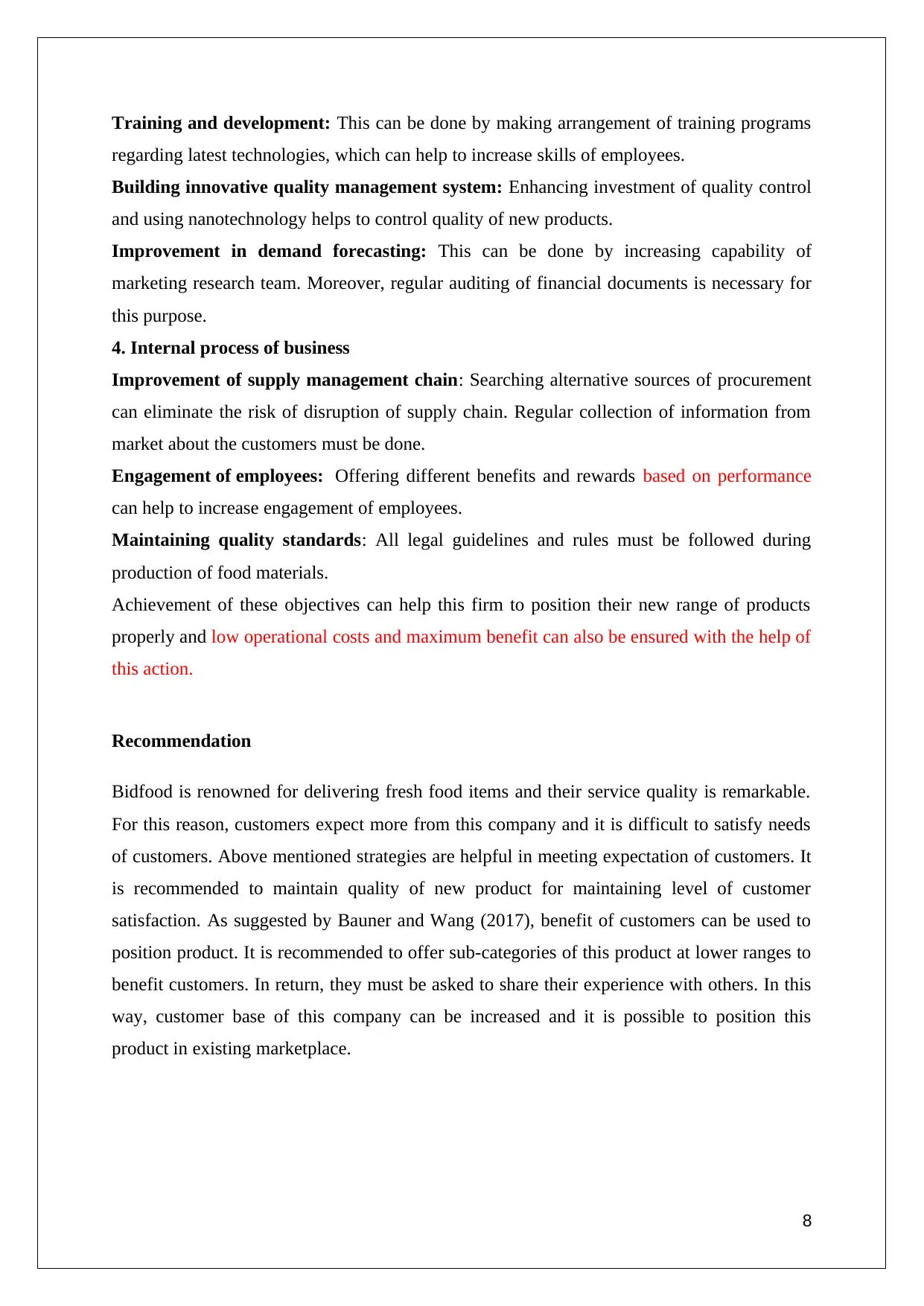
Training and development: This can be done by making arrangement of training programs
regarding latest technologies, which can help to increase skills of employees.
Building innovative quality management system: Enhancing investment of quality control
and using nanotechnology helps to control quality of new products.
Improvement in demand forecasting: This can be done by increasing capability of
marketing research team. Moreover, regular auditing of financial documents is necessary for
this purpose.
4. Internal process of business
Improvement of supply management chain: Searching alternative sources of procurement
can eliminate the risk of disruption of supply chain. Regular collection of information from
market about the customers must be done.
Engagement of employees: Offering different benefits and rewards based on performance
can help to increase engagement of employees.
Maintaining quality standards: All legal guidelines and rules must be followed during
production of food materials.
Achievement of these objectives can help this firm to position their new range of products
properly and low operational costs and maximum benefit can also be ensured with the help of
this action.
Recommendation
Bidfood is renowned for delivering fresh food items and their service quality is remarkable.
For this reason, customers expect more from this company and it is difficult to satisfy needs
of customers. Above mentioned strategies are helpful in meeting expectation of customers. It
is recommended to maintain quality of new product for maintaining level of customer
satisfaction. As suggested by Bauner and Wang (2017), benefit of customers can be used to
position product. It is recommended to offer sub-categories of this product at lower ranges to
benefit customers. In return, they must be asked to share their experience with others. In this
way, customer base of this company can be increased and it is possible to position this
product in existing marketplace.
8
regarding latest technologies, which can help to increase skills of employees.
Building innovative quality management system: Enhancing investment of quality control
and using nanotechnology helps to control quality of new products.
Improvement in demand forecasting: This can be done by increasing capability of
marketing research team. Moreover, regular auditing of financial documents is necessary for
this purpose.
4. Internal process of business
Improvement of supply management chain: Searching alternative sources of procurement
can eliminate the risk of disruption of supply chain. Regular collection of information from
market about the customers must be done.
Engagement of employees: Offering different benefits and rewards based on performance
can help to increase engagement of employees.
Maintaining quality standards: All legal guidelines and rules must be followed during
production of food materials.
Achievement of these objectives can help this firm to position their new range of products
properly and low operational costs and maximum benefit can also be ensured with the help of
this action.
Recommendation
Bidfood is renowned for delivering fresh food items and their service quality is remarkable.
For this reason, customers expect more from this company and it is difficult to satisfy needs
of customers. Above mentioned strategies are helpful in meeting expectation of customers. It
is recommended to maintain quality of new product for maintaining level of customer
satisfaction. As suggested by Bauner and Wang (2017), benefit of customers can be used to
position product. It is recommended to offer sub-categories of this product at lower ranges to
benefit customers. In return, they must be asked to share their experience with others. In this
way, customer base of this company can be increased and it is possible to position this
product in existing marketplace.
8
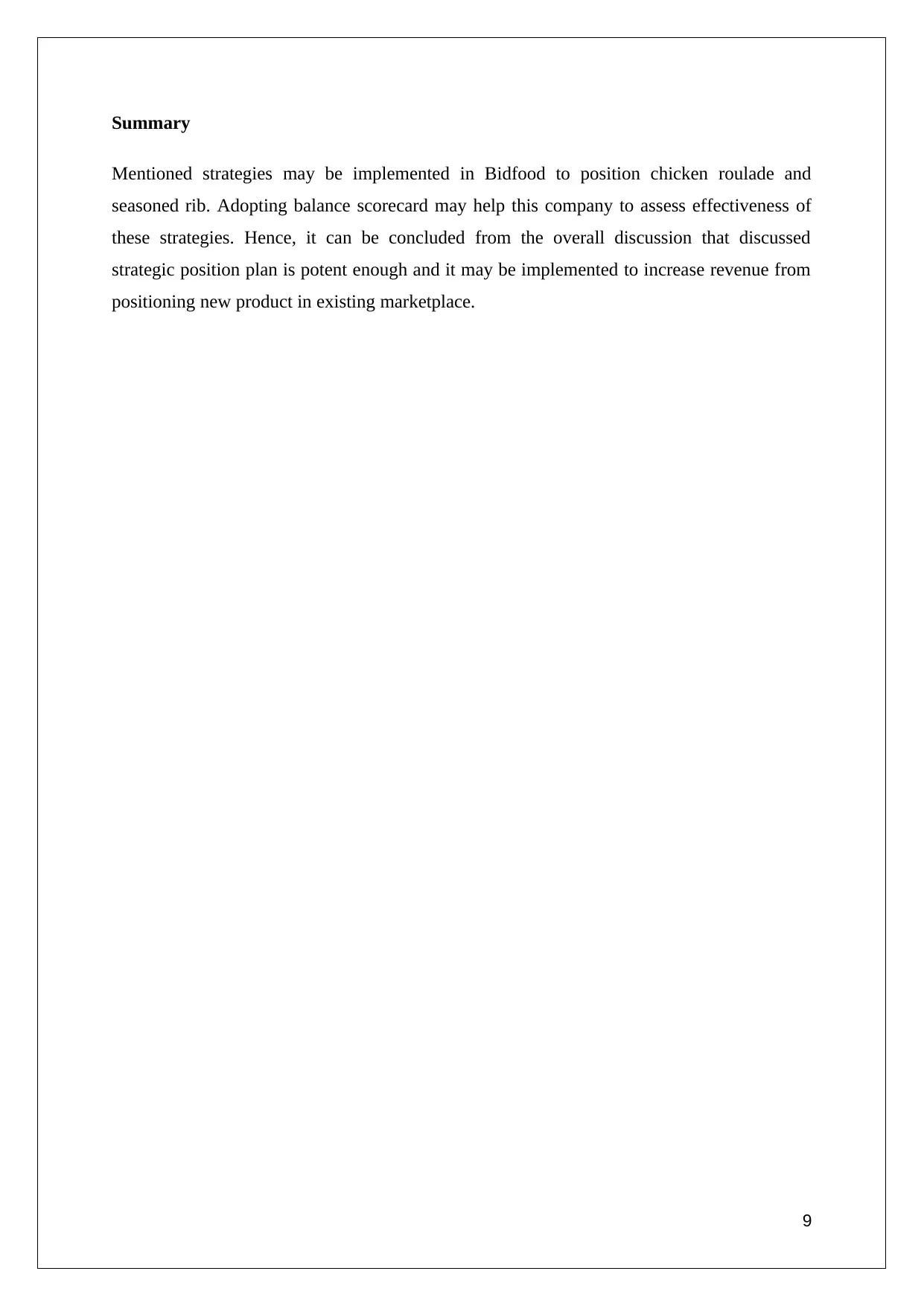
Summary
Mentioned strategies may be implemented in Bidfood to position chicken roulade and
seasoned rib. Adopting balance scorecard may help this company to assess effectiveness of
these strategies. Hence, it can be concluded from the overall discussion that discussed
strategic position plan is potent enough and it may be implemented to increase revenue from
positioning new product in existing marketplace.
9
Mentioned strategies may be implemented in Bidfood to position chicken roulade and
seasoned rib. Adopting balance scorecard may help this company to assess effectiveness of
these strategies. Hence, it can be concluded from the overall discussion that discussed
strategic position plan is potent enough and it may be implemented to increase revenue from
positioning new product in existing marketplace.
9
⊘ This is a preview!⊘
Do you want full access?
Subscribe today to unlock all pages.

Trusted by 1+ million students worldwide
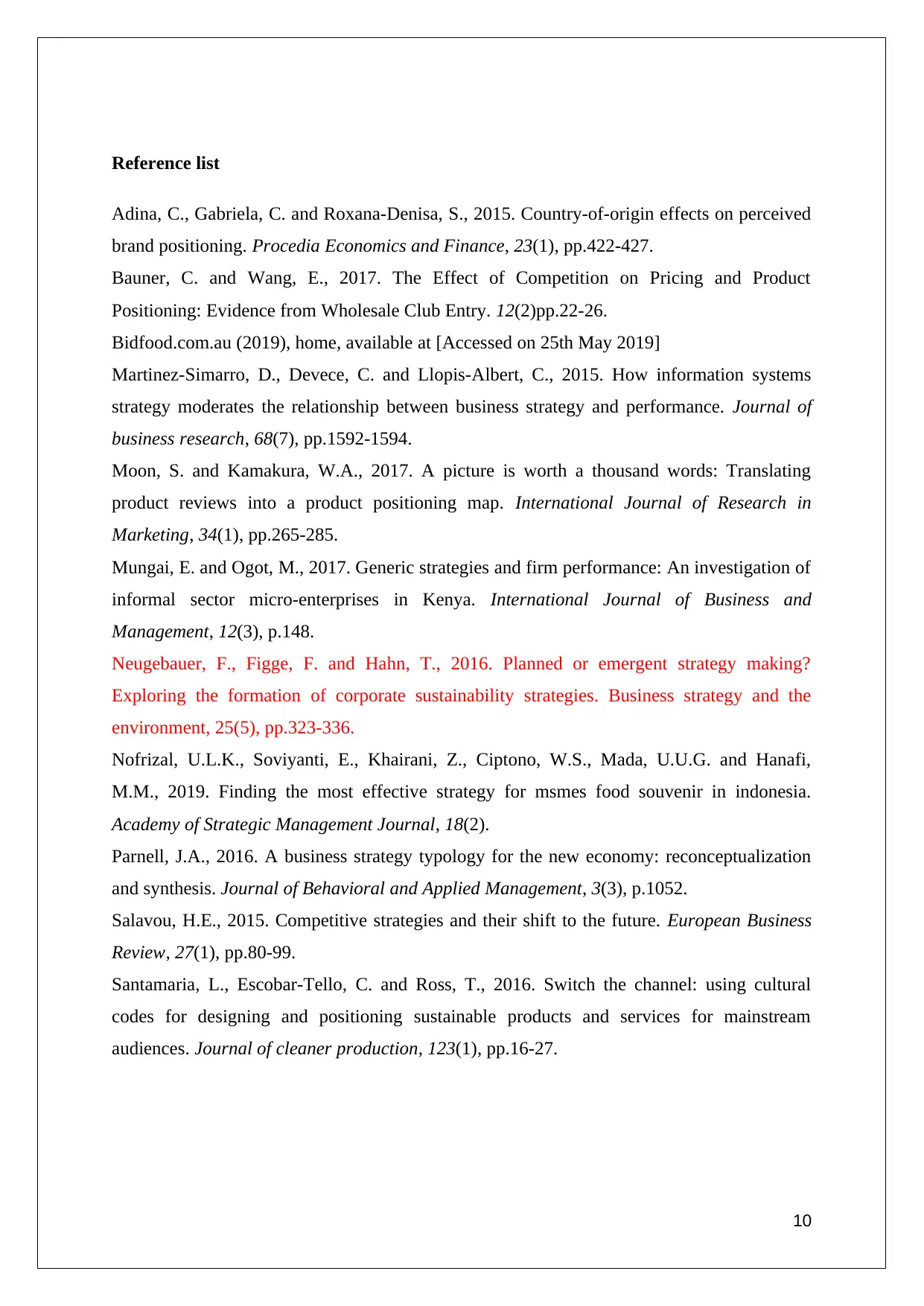
Reference list
Adina, C., Gabriela, C. and Roxana-Denisa, S., 2015. Country-of-origin effects on perceived
brand positioning. Procedia Economics and Finance, 23(1), pp.422-427.
Bauner, C. and Wang, E., 2017. The Effect of Competition on Pricing and Product
Positioning: Evidence from Wholesale Club Entry. 12(2)pp.22-26.
Bidfood.com.au (2019), home, available at [Accessed on 25th May 2019]
Martinez-Simarro, D., Devece, C. and Llopis-Albert, C., 2015. How information systems
strategy moderates the relationship between business strategy and performance. Journal of
business research, 68(7), pp.1592-1594.
Moon, S. and Kamakura, W.A., 2017. A picture is worth a thousand words: Translating
product reviews into a product positioning map. International Journal of Research in
Marketing, 34(1), pp.265-285.
Mungai, E. and Ogot, M., 2017. Generic strategies and firm performance: An investigation of
informal sector micro-enterprises in Kenya. International Journal of Business and
Management, 12(3), p.148.
Neugebauer, F., Figge, F. and Hahn, T., 2016. Planned or emergent strategy making?
Exploring the formation of corporate sustainability strategies. Business strategy and the
environment, 25(5), pp.323-336.
Nofrizal, U.L.K., Soviyanti, E., Khairani, Z., Ciptono, W.S., Mada, U.U.G. and Hanafi,
M.M., 2019. Finding the most effective strategy for msmes food souvenir in indonesia.
Academy of Strategic Management Journal, 18(2).
Parnell, J.A., 2016. A business strategy typology for the new economy: reconceptualization
and synthesis. Journal of Behavioral and Applied Management, 3(3), p.1052.
Salavou, H.E., 2015. Competitive strategies and their shift to the future. European Business
Review, 27(1), pp.80-99.
Santamaria, L., Escobar-Tello, C. and Ross, T., 2016. Switch the channel: using cultural
codes for designing and positioning sustainable products and services for mainstream
audiences. Journal of cleaner production, 123(1), pp.16-27.
10
Adina, C., Gabriela, C. and Roxana-Denisa, S., 2015. Country-of-origin effects on perceived
brand positioning. Procedia Economics and Finance, 23(1), pp.422-427.
Bauner, C. and Wang, E., 2017. The Effect of Competition on Pricing and Product
Positioning: Evidence from Wholesale Club Entry. 12(2)pp.22-26.
Bidfood.com.au (2019), home, available at [Accessed on 25th May 2019]
Martinez-Simarro, D., Devece, C. and Llopis-Albert, C., 2015. How information systems
strategy moderates the relationship between business strategy and performance. Journal of
business research, 68(7), pp.1592-1594.
Moon, S. and Kamakura, W.A., 2017. A picture is worth a thousand words: Translating
product reviews into a product positioning map. International Journal of Research in
Marketing, 34(1), pp.265-285.
Mungai, E. and Ogot, M., 2017. Generic strategies and firm performance: An investigation of
informal sector micro-enterprises in Kenya. International Journal of Business and
Management, 12(3), p.148.
Neugebauer, F., Figge, F. and Hahn, T., 2016. Planned or emergent strategy making?
Exploring the formation of corporate sustainability strategies. Business strategy and the
environment, 25(5), pp.323-336.
Nofrizal, U.L.K., Soviyanti, E., Khairani, Z., Ciptono, W.S., Mada, U.U.G. and Hanafi,
M.M., 2019. Finding the most effective strategy for msmes food souvenir in indonesia.
Academy of Strategic Management Journal, 18(2).
Parnell, J.A., 2016. A business strategy typology for the new economy: reconceptualization
and synthesis. Journal of Behavioral and Applied Management, 3(3), p.1052.
Salavou, H.E., 2015. Competitive strategies and their shift to the future. European Business
Review, 27(1), pp.80-99.
Santamaria, L., Escobar-Tello, C. and Ross, T., 2016. Switch the channel: using cultural
codes for designing and positioning sustainable products and services for mainstream
audiences. Journal of cleaner production, 123(1), pp.16-27.
10
1 out of 10
Related Documents
Your All-in-One AI-Powered Toolkit for Academic Success.
+13062052269
info@desklib.com
Available 24*7 on WhatsApp / Email
![[object Object]](/_next/static/media/star-bottom.7253800d.svg)
Unlock your academic potential
Copyright © 2020–2025 A2Z Services. All Rights Reserved. Developed and managed by ZUCOL.





